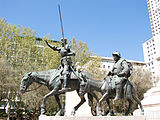Plaza de España, Madrid
You can help expand this article with text translated from the corresponding article in Spanish. (January 2015) Click [show] for important translation instructions.
|

Plaza de España (Error: {{language with name/for}}: missing language tag or language name (help)) is a large square, a popular tourist destination located in central Madrid, Spain at the western end of the Gran Vía. It features a monument to Miguel de Cervantes Saavedra and is adjacent to two of Madrid's most prominent skyscrapers. Additionally, the Palacio Real (Royal Palace) is only a short walk south from the plaza.
Cervantes Monument
The center of the plaza features a monument to Spanish novelist, poet and playwright Miguel de Cervantes Saavedra designed by architects Rafael Martínez Zapatero and Pedro Muguruza, and by the sculptor Lorenzo Coullaut Valera. Most of the monument was built between 1925 and 1930. It was finished between 1956 and 1957 by Federico Coullaut-Valera Mendigutia, the son of the original sculptor.
The tower portion of the monument includes a stone sculpture of Cervantes overlooking bronze sculptures of Don Quixote and Sancho Panza. Next to the tower, there are two stone representations of Don Quixote's "true love", one as the simple peasant woman Aldonza Lorenzo, and one as the beautiful, imaginary Dulcinea del Toboso.
-
Stone sculpture of Miguel de Cervantes
-
North-eastern side of the Cervantes monument
-
Bronze sculptures of Don Quixote and Sancho Panza
-
Bronze sculptures of Don Quixote and Sancho Panza
-
Stone sculpture of Aldonza Lorenzo
-
Plaza de España, Madrid.
Surrounding buildings

Adjacent to the plaza are two of the tallest buildings in Madrid, the 142 m (466 ft) Torre de Madrid ("Madrid Tower"), built in 1957 and the 117 m (384 ft) tall Edificio España ("Spain Building"), built in 1953.[1]
There, you will also find the House of Gallardo, built in 1911, considered one of the notable examples of the Art Nouveau style of architecture in the city.
Metro station
Plaza de España is also the name of a Metro station located on the eastern corner of the plaza, serviced by the #3 and #10 lines, with a connection to the #2 line.[2]
History

In 1808, the area was part of the Príncipe Pío hill. It was one of the locations used by French firing squads to execute prisoners taken during the May 2nd uprising.
Notes
- ^ "Madrid Skyscraper Diagram". Skyscraper Source Media. Retrieved 14 January 2015.
- ^ es:Plaza de España (Metro de Madrid)
References
- Madrid Skyscrapers at skyscraperpage.com
- Estación de Plaza de España / Noviciado from the Spanish-language Wikipedia article. Retrieved May 20, 2006.
- Plaza de España (Madrid) from the Spanish-language Wikipedia article. Retrieved May 20, 2006.






